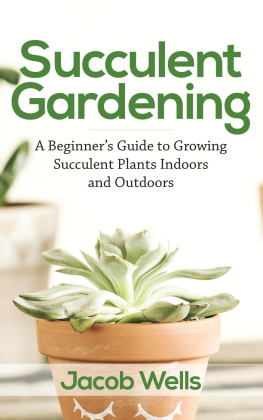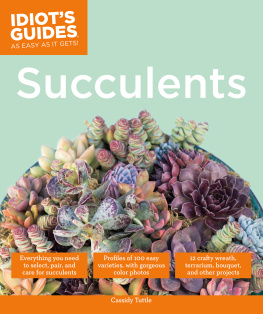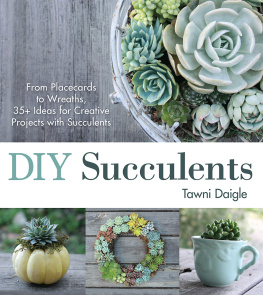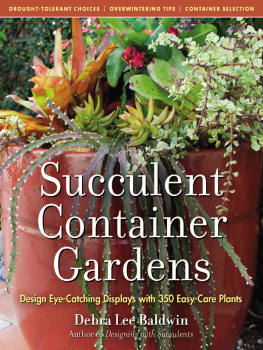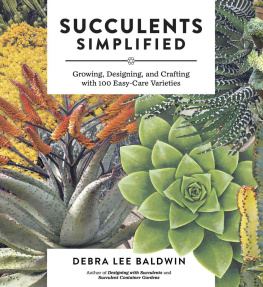
The color, shape, and form of a dragon trees foliage repeat those of a nearby dasylirion in Jeanne Meadows Fallbrook, California, succulent garden.
Designing with Succulents
Debra Lee Baldwin
Timber Press
Portland, Oregon

Agave Sharkskin
To Jeff, Art, and Sandra
Contents
Preface
A Decade of Innovation in Succulent Design
The world of succulent design has advanced so significantly since the first edition of Designing with Succulents was released in 2007 that this second edition is a complete rewritein effect, a new book. It showcases the cleverness and creativity of numerous designers and gardening enthusiasts, many of whom used the first edition as a starting point.
When I was writing the first edition, many varieties we now take for granted, such as echeverias, were nearly unknown. The gardening public thought of succulents as cactus or jade and dismissed the entire category as too spiny or common. If finding enough sophisticated, well-designed in-ground gardens to fill a book was challenging, identifying the plants proved even more so. Horticulturists, growers, and collectorsby and large pleasant eccentrics who didnt do emailwould agree on genera but not necessarily species or cultivars.
Since then, interest in water-storing plants has surged due to the Wests ongoing drought and wildfire concerns. Moreover, the gardening public, grown weary of trying to replicate English flower gardens, has become interested in form and foliage. Time-stressed homeowners want plants that wont die if neglected and that look the same for months. Women, who now constitute the majority of succulent aficionados, have become captivated by rosette varieties. Brides and florists have discovered that pale blue, dove gray, and teal echeverias lend a fresh look to bouquets and centerpieces. Numerous succulent-oriented businesses have sprung up as growers, hybridizers, designers, and nursery owners have scrambled to meet the demand.
The popularity of succulents is also evidenced by their strong Internet presence, frequent social media mentions, and use as decor in movies, television shows, and advertisements. Its much easier to identify succulents nowadays, thanks to a greater number of experts, enthusiasts, and collectors, many of them devoted to certain genera (such as Aloe or Haworthia) or subcategories (such as caudiciforms or cacti).
When I began working on this celebratory tenth anniversary edition, my biggest challenge was the opposite of what I faced with the first edition: an overabundance of beautifully designed succulent gardens. Much time went into selecting best-of-the-best photos to illustrate design ideas and to showcase this new editions featured gardens.
Because I enjoy cultivating a wide variety of succulents as well as using them to create a visual adventure, my own half acre is a living laboratory of plants plus ideas gleaned from designers, fellow gardeners, and trial and error. Photos of my garden appear in the introduction and elsewhere, especially the chapter on specialty gardens.
You, too, can create the low-water garden of your dreams. Whether youre a longtime fan of fleshy leaved plants or new to them, its my pleasure to share with you, in these proudly updated pages, the beauty, practicality, and creativity inherent in designing with succulents.

Echeverias pair well with roses in bridal bouquets and can later be planted as a living memento of the event.
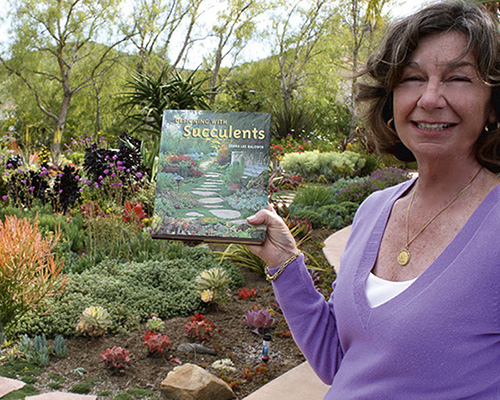
Homeowner Elisabeth Matthys, shown here, asked designer Linda Bresler to create a landscape similar to the one pictured on the cover of the first edition of Designing with Succulents. The outcome received San Diego Home/Garden magazines prestigious Garden of the Year award.
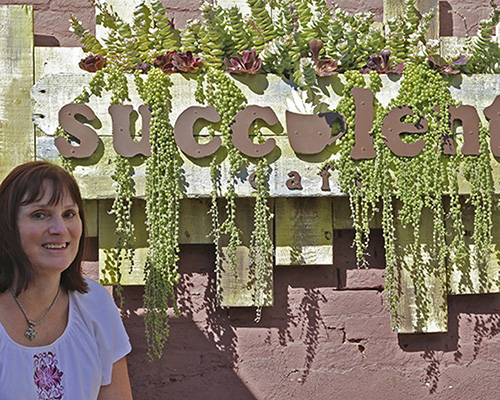
After it opened in 2011, the Succulent Caf in Oceanside, California, became a destination for enthusiasts worldwide. Noreen Fenton of Succulent Surroundings came to visit from Santa Rosa, nearly 500 miles away.
Introduction
The Aesthetics of Succulents

Much of the fun of collecting art pottery is selecting the perfect succulent for a special container and vice versa. Such pairings make the most of limited space.

The focal point succulent, a euphorbia, is a living sculpture suggestive of a saguaro; its framed by another euphorbia (Sticks on Fire) that picks up the rosy peach of the wall.
Succulent describes any plant that survives drought by storing water in its leaves, stems, or roots. These plants were far from my mind when I began gardening in my early thirties. Because I wanted big, bold, beautiful flowers, I planted cannas and rose bushes, despite the fact that in southern California (USDA zone 9) rain falls minimally and mostly in February, the soil lacks nutrients, and inland temperatures range from 25 to 105F. From spring through fall, such plants continually need mulching, fertilizing, pruning, spraying, irrigating, and deadheading.
As a garden photojournalist, I was influenced by editors, design professionals, colleagues, homeowners, and horticulturists who believed that gardening is an endeavor that ought to suit the region. It was my job to communicate via words and photos why certain residential outdoor environments were innovative and appealingnot only visually but also practically. As I strove to entertain and enlighten the gardening public, I became inspired myself.
One midwinter, when my garden consisted of pruned and naked rose bushes, cannas with frost-burned leaves, and perennials that had been cut to the ground, I visited the garden of horticulturist Patrick Anderson midway between Los Angeles and San Diego. Despite its poor soil and lack of irrigation, his garden was lush and colorful. It was the first time I had seen large aloes in a garden setting. The ensuing article reflected my fascination: Fleshy green monsters in Patrick Andersons Fallbrook garden look like they might snap him up if he turns his back, it began. Theyre giant succulents, and Andersons half-acre hillside showcases hundreds of unusual ones. I described aloes that pierce the sky like exotic torchbearers, hot orange against cool blue, and agaves that sprawl like squids, or explode upward like fistfuls of knives.
I noticed how two or three varieties of succulents selected for shape, color, and texture create elegant and eye-catching vignettes. Succulents with curved or undulating leaves suggest motion, which makes any garden more interesting. Moreover, like seashells and snowflakes, succulent foliage forms patterns that illustrate natures innate geometry and that are mesmerizing when repeated.
Next page










